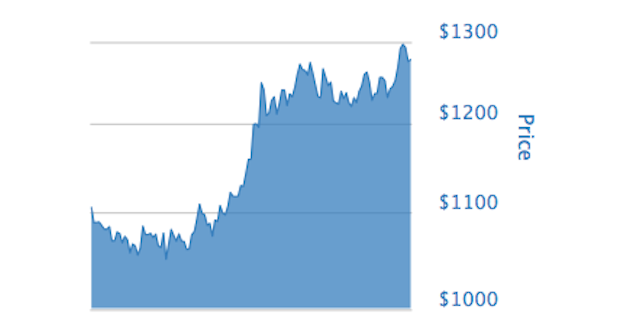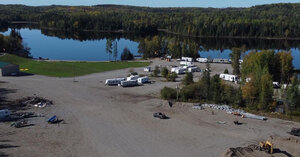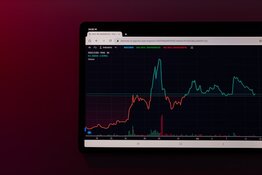The Gold Report: What's your macro outlook for gold?
Joe Reagor: International debt concerns are going to drive gold this year into next year, in our view. A number of countries with mounting debt loads can't continue to pay the interest portion of their debt, let alone ever pay it back. Total world debt continues to increase year after year. If the solution is for everybody to print the money that they need to pay everybody else back with, that's going to be a massive inflationary event, which would bode well for gold.
TGR: Silver has been up dramatically vis-à-vis gold. Do you expect that trend to continue?
JR: When gold started to catch in the early part of this year, silver didn't. Traditionally, it's been the reverse; when a recovery begins, silver moves first because it's the tighter market and, therefore, easier to be moved by the money coming into the sector. That said, we think the silver-gold ratio could contract down to 65:1 as a baseline level, but I don't expect it to return to 50:1, which we saw during the height of the gold and silver rally.
"Integra Gold Corp. is a potential future producer that won't need a large investment."
The other side is not just the macroeconomics of the world, but also the individual fundamentals of gold versus silver and their natural rarity. Silver and gold's recoverable rarity in nature is somewhere in the neighborhood of 70–75:1, so we can expect silver to trend around that level, maybe at a slight premium because it has more industrial uses than gold.
TGR: In your coverage, you have focused on advanced projects either in development or in production. Why is this?
JR: We have a strong focus on companies with advanced exploration and those nearing or entering development. The one company we have that is a producer is Coeur Mining Inc. (CDE:NYSE). It's hard for the producing mining companies, especially the larger they are, to move the needle for investors beyond simply being a proxy for what gold and silver are going to do. We made an exception for Coeur because we believe it was doing what it had to do to move the needle, and we've seen that in its significant outperformance this year. The companies that are in the exploration or development stages have the ability to move up the value curve.
In the exploration basket, there are two significant events that generally drive the most increase in valuation. The first is at discovery—initial drill holes on a project, small-cap oriented, almost too small for the institutional investor. At that point, most of the calls being made are by analysts with geological backgrounds. For a non-geologist like me, it's tougher to make a judgment call there.
"MAG Silver Corp. raised some money earlier this year, and it came out of that very strong."
Then there's a lull from the initial discovery up until a project starts to approach the possibility of development or acquisition. During that time, the catalysts are few and far between. We believe that you either want the really early-stage companies or those that are nearing that event that's going to trigger a valuation improvement. That's why we've focused on stocks that are in near-term development, either currently in development or about to be, as the majority of our coverage list.
TGR: Would you tell us about some of your best picks and why?
JR: Coeur is one of our top picks because it really has improved its economics, cash flow generation and costs at a number of its mines while setting itself up to de-lever in a rising gold and silver price environment. It started to get some of that credit already from the market, but we believe there's still some room to go there. It was our top mining idea coming into the year.
We like Pretium Resources Inc. (PVG:TSX; PVG:NYSE) and MAG Silver Corp. (MAG:TSX; MVG:NYSE) because they're both very high-quality assets with a large number of ounces, gold and silver respectively, high grade, in good jurisdictions and have solid management teams with proven track records. If a company has those things, then it's in a position to generate a world-class producing asset. If it's not already interesting in production, it will still be interesting as a potential acquisition target to the larger players that have struggled to replace production and reserves over the last few years.
"Pretium Resources Corp.'s project is a low-grade halo around some record-high gold intercepts."
On the smaller side, we like companies that are approaching that initial construction/development decision, but we prefer them to have a lower capital expenditure project if they're going to be developing it on their own and they're not major potential takeout targets. Along those lines, we have under coverage Pershing Gold Corp. (PGLC:NASDAQ) and Integra Gold Corp. (ICG:TSX.V; ICGQF:OTCQX). Pershing is looking at a $12 million ($12M) budget to put its asset into production. It is very reasonable for a small-cap mining company to raise that amount of capital. Integra Gold is looking at probably a $50–100M budget but at a very high rate of return, north of 70%, because it already has a built mill site that just needed to be refurbished. Bringing those capital numbers down to sub-$100M makes it a potential future producer that won't need a large investment or acquisition.
TGR: Do you think MAG, being a silver company, will get an extra push in light of silver's appreciation?
JR: I think it already has. The company did raise some money earlier this year, and it came out of that very strong. The valuation has moved significantly higher since before the raise was announced. I think that's a demonstration of 1) the silver price outperformance of gold over the last month or two and 2) that the company is now in position to fund its share of its project, if it isn't acquired before the development decision is announced. Its larger partner, Fresnillo Plc (FRES:LSE), has the power to make that development decision, which we expect sometime this year. But there is less risk for an investor now, which was part of the reason for its outperformance in the last few months.
TGR: Pretium recently put out a news release with more drilling results. Anything new there?
JR: It's further confirmation of what everyone sees in that deposit. It's essentially a low-grade halo around some record-high gold intercepts over very short lengths, sub-5 meter (sub-5m) intercepts, sometimes sub-1m intercepts of apparently significant high-grade gold. Having been underground at that deposit, I saw spots in the wall where a drill hole missed by two or three inches what would have been a significant high-grade intercept. Instead, it shows up as just a low-grade intercept. So the point of Pretium's infill drilling is to delineate as much as it can an estimate of what production might look like, so that it can provide reasonable guidance to the market once it's in production sometime next year. One of the concerns that a lot of people still have is it will be very difficult to put a range on what production will be, given the highly variable nature of the deposit. That's why it's still doing additional drilling, even as it brings it into development.
TGR: Integra got a lot of publicity with its $1 Million Gold Rush Challenge. What was the net benefit to the company?
JR: If you look at what it costs to hire one geologist to do the work to make the decisions of where to put your next couple million dollars' worth of drilling, you're looking at a quarter of a million dollars for one person's input. Instead, it got the input of well north of 50 people, sometimes even groups of geologists, for $1M because it's been a down market, and there are a lot of people who are underutilized. It was a creative way for Integra to generate ideas for where to explore for the next 5 or 10 years, at the cost of essentially four geologists. It's a good return for the investors. Plus a big portion of it was funded by sponsors, so it didn't even have too much of an upfront cost on its own part.
TGR: Do you have any parting thoughts for our readers?
JR: People need to have cautious optimism in this market, that gold and silver could go higher, but not base investments decisions on that. It's most valuable to pick companies that are in the right position with the right upcoming catalysts to drive the valuation higher, regardless of what gold and silver prices do.
During previous up cycles, investors would buy practically anything and the investment would do OK. That mentality resulted in more investors not spending enough time learning the specifics of the companies to understand which ones had that potential to outperform their peers. That's the approach that we've taken. We've spent less time on macro—where are gold and silver going—and more time on picking the right companies that are at the right stage in their development.
TGR: Thanks for your insights, Joe.
Joe Reagor is a research analyst with ROTH Capital Partners, providing equity research coverage of the natural resources sector. Prior to ROTH, he worked in equity research at Global Hunter Securities and at Very Independent Research, covering a wide array of resources companies including metals (steel and aluminum), mining (gold, silver and base metals) and forest products (containerboard, OCC, UFS and pulp). Reagor earned a Bachelor of Arts in economics and mathematics from Monmouth University.
Read what other experts are saying about:
Want to read more Gold Report interviews like this? Sign up for our free e-newsletter, and you'll learn when new articles have been published. To see recent interviews with industry analysts and commentators, visit our Streetwise Interviews page.
Disclosure:
1) Patrice Fusillo conducted this interview for Streetwise Reports LLC, publisher of The Gold Report, The Energy Report and The Life Sciences Report and is an employee of Streetwise Reports. She owns, or her family owns, shares of the following companies mentioned in this interview: None.
2) The following companies mentioned in the interview are sponsors of Streetwise Reports: Pretium Resources Inc., MAG Silver Corp., Integra Gold Corp. and Pershing Gold Corp. The companies mentioned in this interview were not involved in any aspect of the interview preparation or post-interview editing so the expert could speak independently about the sector. Streetwise Reports does not accept stock in exchange for its services. The information provided above is for informational purposes only and is not a recommendation to buy or sell any security.
3) Joe Reagor: I own, or my family owns, shares of the following companies mentioned in this interview: None. I personally am, or my family is, paid by the following companies mentioned in this interview: None. ROTH Capital Partners disclosures available here. I was not paid by Streetwise Reports for participating in this interview. Comments and opinions expressed are my own comments and opinions. I determined and had final say over which companies would be included in the interview based on my research, understanding of the sector and interview theme. I had the opportunity to review the interview for accuracy as of the date of the interview and am responsible for the content of the interview.
4) Interviews are edited for clarity. Streetwise Reports does not make editorial comments or change experts' statements without their consent.
5) The interview does not constitute investment advice. Each reader is encouraged to consult with his or her individual financial professional and any action a reader takes as a result of information presented here is his or her own responsibility. By opening this page, each reader accepts and agrees to Streetwise Reports' terms of use and full legal disclaimer.
6) From time to time, Streetwise Reports LLC and its directors, officers, employees or members of their families, as well as persons interviewed for articles and interviews on the site, may have a long or short position in securities mentioned. Directors, officers, employees or members of their families are prohibited from making purchases and/or sales of those securities in the open market or otherwise during the up-to-four-week interval from the time of the interview until after it publishes.









































